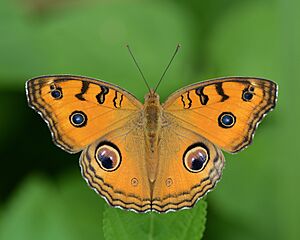Peacock pansy facts for kids
Quick facts for kids Peacock pansy |
|
|---|---|
 |
|
| Conservation status | |
| Scientific classification | |
| Synonyms | |
|
The Peacock Pansy (scientific name: Junonia almana) is a beautiful butterfly found in places like Cambodia and South Asia. It belongs to a family of butterflies called Nymphalidae.
What's really cool about this butterfly is that it can look different depending on the time of year! It has two main forms: one for the dry season and one for the wet season. These forms mostly differ in the patterns on the underside of their wings. The dry-season form has fewer markings, while the wet-season form shows off more eyespots and lines. The Peacock Pansy is currently listed as a species of Least Concern by the IUCN Red List, which means it's not in danger of disappearing.
Contents
What Does the Peacock Pansy Look Like?
Adult Peacock Pansy butterflies have a wingspan of about 54 to 62 millimeters (that's about 2 to 2.4 inches). They show something called seasonal polyphenism. This means their appearance changes with the seasons.
Dry-Season Form
During the dry season, the Peacock Pansy butterfly has wings that are mostly a rich orange-yellow color on top. The front wings have some dark lines and a large, round "eyespot" pattern. This eyespot has a tiny white center and a thin black ring around it. The back wings also have eyespots, with a larger one that can look brownish-orange or bluish-black in the center.
The underside of the wings is usually an ochre (yellowish-brown) color. It often has faint, wavy dark bands. These patterns help the butterfly blend in with dry leaves and surroundings.
Wet-Season Form
When the wet season arrives, the Peacock Pansy's top side looks similar, but its black markings are darker and bolder. The lines on the wings are also much clearer.
The underside of the wet-season form is usually a pale ochre color. It has more distinct dark brown lines and patterns. The eyespots on the underside are also more noticeable, sometimes with a double ring around them. These brighter patterns might help the butterfly stand out or confuse predators in the lush, green wet-season environment.
Where Do Peacock Pansies Live?
You can find J. almana butterflies across a wide area. They live in countries like India and Sri Lanka, and also throughout South East Asia. Their range extends eastwards all the way to China and Japan.
Life Cycle of the Peacock Pansy
Like all butterflies, the Peacock Pansy goes through several stages in its life.
The Caterpillar (Larva)
The caterpillars of the Peacock Pansy eat leaves from various plants. Some of their favorite plants include Hygrophila auriculata, Phyla nodiflora, and species from the Acanthus, Barleria, and Gloxinia plant families.
The caterpillar itself is shaped like a cylinder. Its head is dark and a little bit hairy. Its body is a pale yellowish-brown color. It has dark lines running along its back and sides. It also has rows of small, ring-shaped spots. The caterpillar's body is covered with short, branched spines.
The Pupa
After the caterpillar has grown enough, it turns into a pupa. The pupa of the Peacock Pansy is quite short and thick. Its head and chest area are wide, and the head part points downwards. Both the chest and belly sections have small, bumpy points on their backs. The pupa is usually a brownish-yellow color.
Images for kids





